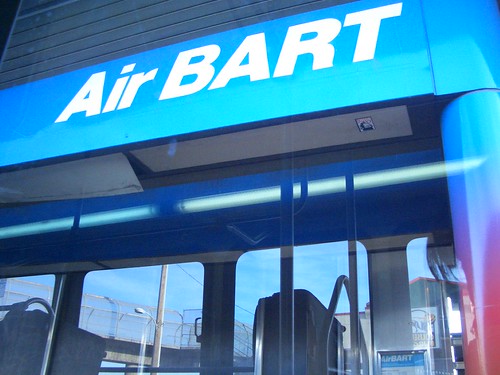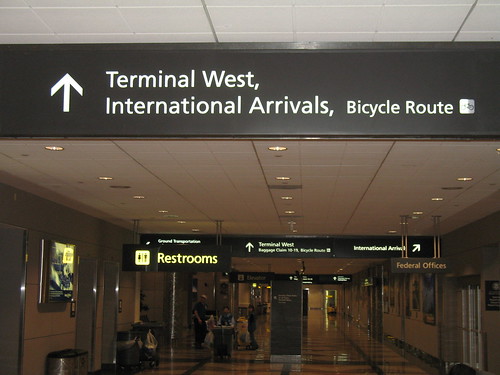This was the line at Jack London Square ferry terminal at 8:30 am yesterday morning, captured by a KQED News reporter (while riding a bike).
Tag: oakland
Planes, Trains, and Automobiles (and Bikes, and Buses)
Whether for work, vacation, picking up or dropping off a friend – a trip to the airport is nearly as common as as trip to the market. But what is the best way to get there? Undoubtedly the simplest choice for some trips to the airport may be to drive but there’s a whole menu of transport options to choose from and consider. Let’s look at other options for getting to two of the Bay Area’s major international airports– SFO and Oakland International

AirBART. Photo credit: Tzuhsun Hsu
SFO and Oakland International are both serviced by BART. BART can be a viable alternative to driving and serves a wide number of Bay Area residents. Rather than driving to the airport and hassling with parking ride BART. This way you are relieved of the duty of driving; definitely an option for the no nonsense traveler. If you are traveling from Contra Costa County to SFO, BART is definitely the way to go. If you are traveling from Contra Costa County to the Oakland International Airport, BART plus the AirBART bus from Oakland Coliseum BART Station is your alternative. Remember to carry $3 in cash or a $3 BART pass to pay for the AirBART connector from BART to the Oakland International Airport.
There’s also the option of taking the bus. While you would still be on the same roadways as cars, buses can use the HOV lane during peak hours M-F and traveling by bus also relieves you from the duty of driving, and parking. There are a number of bus options but AC Transit is likely the best bus option from West Contra Costa to the Oakland International.

Bike friendly design as seen in Denver International Airport. Photo credit: Richard Masoner
And for you daredevil bicycle travelers, there are bike access options nowadays to the airports. SFO can be reached locally by designated bike routes and offers of bike parking – even valet bike parking! Oakland International has class 1 bike path and class 2 bike lanes that link Oakland International Airport terminals with the cities of Oakland, Alameda and San Leandro.
There seems to be an ongoing, collective conversation about ways of traveling to and from the airport these days. Here in the Bay Area, Oakland North recently tested four different modes – bus, bike, BART, and car – against each other in a “race to Oakland International“. An article (with video included of each traveler), it’s well worth a read that highlights not only the convenience and route choice of different modes, but also the time and cost involved. Meanwhile in Canada, James Schwartz of The Urban Country shared his personal account of traveling to and from Toronto Inernational by bike.
It’s not unusual to think “I’m heading to the airport” and instinctively decide to drive, catch a ride with a friend, or go by taxi, but these are not the only options at your disposal. At times, you may find it convenient or cost-effective to reach the airport by a different mode, or mixing modes– like catching a taxi to BART or biking to a bus stop and taking your bike on AC Transit to reach the airport. Interested in trying a new mode to reach the airport? Check out directions getting to and from SFO and Oakland International by all modes.
Building Community, Opportunity and Fixing Bikes in East Oakland

The exterior of Bike Oven, a volunteer-run bicycle repair collective in Northeast Los Angeles. Photo credit:Mike Wally
In the Bay Area, when discussing the role of the bicycle in daily life it is easy to get fixated on the environmental and health benefits this humble machine brings to the urban environment. However, as the bicycle cooperative ColectíVelo shows us in the Fruitvale neighborhood of East Oakland, there are other facets and benefits of bicycling which are perhaps too often overlooked. ColectíVelo, like many other bicycle cooperatives, offers an environment where one can repair bicycles, get guidance in bike repair, and even build a bicycle for free or in exchange for volunteering.
However, there are a few things that set ColectíVelo apart from your typical bike-coop. As mentioned in an East Bay Express profile of ColectíVelo:
The idea for the shop was conceived five years ago, when a public health nurse and her social worker colleagues saw a need for affordable, efficient transportation among the day laborers they served in Fruitvale. [The founders] dreamed of a bike shop for them, and for the other low-income residents of the neighborhood.
These days when the image of a cyclist as someone who is hip, well-off and perhaps even a little smug is circulating, it may worth noting that many people cycle out of necessity. Bicycle cooperatives don’t just serve the hobbyist, they can be valuable resources to people with little money or who have no other means of transportation, as emphasized by ColectíVelo’s main organizer, Morgan Kanninen in the East Bay Express’ recent coverage:
The shop’s eschewing of money is very purposeful: She [Kanninen] pointed out that even sliding-scale systems can contribute to a feeling of inequality among participants. For some, asking to pay at the lower end of a sliding scale can create a “sense of alienation or shame that just does not need to be involved in this bike shop,” she said. “I think it would only hurt the growth of community here, and the real sharing and learning from each other.”
ColectíVelo values the sense of community the collective fosters over monetary profit. It strives to be a welcoming place to people and caters to the local community, being one of few fully bilingual bike cooperatives– the shop provides bike repair training in Spanish and English, and all signage is bilingual. English and Spanish speakers happily work on bikes, side by side and are often able to help each other despite not speaking the same language.
ColectíVelo brings to light the unique opportunity to help build relationships and unify a neighborhood in a safe environment through exchanging knowledge and time, something many other communities could benefit from. Also, as this bike cooperative further illustrates, the bicycle is more than a trendy mode of transportation– it is perhaps the most accessible tool available to all people, of all ages, abilities and incomes – and thanks to ColectíVelo and similar bike repair operations, the bicycle is made that much more accessible.
(Read more about the bike-cooperative in the East Bay Express’ coverage or check out ColectíVelo’s website for more information)
Oakland traffic advisories Friday 8/5 to Saturday 8/6
Below is the schedule of traffic advisories for Oakland from Friday evening to Saturday morning associated with work on the Caldecott Fourth Bore Project.
Eastbound (in Oakland)
Broadway On-Ramp: Closed 8 PM on Friday, August 5 to 8 AM on Saturday, August 6 for the installation of K-Rail.
Vehicles will be detoured to Brookside Avenue in Oakland.
Lane #4 Eastbound 24: Closed between Kay Street Overcrossing and the west end of Bore #1 from 10:30 PM on Friday, August 5 to 6 AM on Saturday, August 6. Bore #1 will tentatively close from midnight until 7 AM, Saturday, August 6.
Westbound (in Oakland)
Caldecott Lane On-Ramp Closure: 9 PM on Friday, August 5 to 8 AM on Saturday, August 6 for the removal of K-Rail.
Caldecott Lane Off-Ramp: 8 PM on Friday, August 5 to 10 AM on Saturday, August 6.
Vehicles will be detoured to the State Route 13 connector ramp.
(Pending) Upcoming Closures in Contra Costa County (August 8, 9)
Westbound Fish Ranch Road Off-Ramp: Closed 9 PM on Monday, August 8 to 5 AM on Tuesday, August 9.
The work is being performed as part of the Caldecott Tunnel Fourth Bore Project. In addition to the excavation of a 3,400-foot-long tunnel north of the existing three bores, the project involves traffic improvements on the eastern and western sides of the tunnel.
For more information on the upcoming ramp closure, visit www.caldecott-tunnel.org
